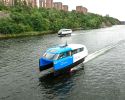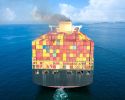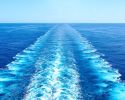DNV: Energy efficiency and new technology are the best tools for reducing climate emissions

In its latest Maritime Forecast to 2050, DNV states that it is impossible for the shipping industry to meet IMO's 2030 target solely with the help of fossil-free fuels. Therefore, the industry must focus more on energy efficiency and technologies such as onboard carbon capture (OCC).
IMO's climate goals are clear: full-scale decarbonization by 2050, and along the way, emissions should be reduced by 20% by 2030 and 70% by 2040, compared to 2008.
So how can shipping achieve this?
Full-scale decarbonization naturally requires a large-scale transition to fossil-free fuels such as methanol, ammonia, and biogas. But considering that not even one percent of the global fleet is green today, it will take many years before a significant portion of it is. To achieve the target of a 20-30% reduction by 2030, the industry would need 48 million tons of oil-equivalent fossil-free fuel. Given that the world’s total production will be between 44 and 63 million, it will be nearly impossible, writes DNV in its latest Maritime Forecast 2050.
It will also become more expensive to operate ships. This year, shipping was incorporated into the EU’s Emissions Trading System (EU ETS), and next year, FuelEU Maritime will require reduced emissions from ships. Stricter technical requirements will also be imposed by IMO. Therefore, according to DNV, the industry must explore all possible options to reduce fuel consumption.
"We must focus on energy efficiency. That is how we can most easily reduce emissions. And there are a number of technologies for this," said Eirik Ovrum, who led the work on the report, when it was launched in Hamburg earlier this week.
Improvements in hulls, propellers, and engines could reduce fuel consumption by 4 to 16 percent by 2030, according to Eirum and DNV.
"16 percent corresponds to 40 million tons of fuel or 120 million tons of greenhouse gases emitted per year. It also corresponds to what we would save if 55,000 smaller ships or 2,500 of the world’s largest ships were converted to run on fossil-free fuels."
If emissions are to be reduced even further, additional technological solutions will be required. DNV highlights carbon capture and storage onboard, fuel cells, wind-assisted propulsion, and waste heat recovery systems as examples of technologies that have already proven to deliver significant emission reductions. If shore power and batteries were to replace the electricity generated by fossil fuels onboard, it could reduce the total energy consumption of ships in ports by 7%. The most cost-effective way to reduce greenhouse gas emissions, according to DNV, is onboard carbon capture and storage (OCC) as it allows the continued use of conventional fuels and technologies.
"But for this to have a major impact, a value chain needs to be developed around OCC, and infrastructure must be built. The technology also needs to be developed, and new regulations need to be established," said Eirik Ovrum.
The report also emphasizes the important role of digitalization in this context. It is not only essential for improving operational and technical energy efficiency measures – digital verification tools are also crucial for building trust, promoting collaboration within the industry, and facilitating new contractual arrangements that encourage energy savings.
-
 Ny studie: Eldrivna pendelbåtar kan effektivisera Stockholms kollektivtrafik
Ny studie: Eldrivna pendelbåtar kan effektivisera Stockholms kollektivtrafik -
 EU: Sjöfartens utsläpp ökar
EU: Sjöfartens utsläpp ökar -
 Sociala relationer påverkar val av bränsle
Sociala relationer påverkar val av bränsle -
 Sjöfartens omställning kräver ”mjukare” påtryckningar
Sjöfartens omställning kräver ”mjukare” påtryckningar -
 Hon hade avtalad tid med Kapten ynkrygg
Hon hade avtalad tid med Kapten ynkrygg -
 Lighthouse omvärldsanalys 2025 – osäkerhet och tullar präglar sjöfarten
Lighthouse omvärldsanalys 2025 – osäkerhet och tullar präglar sjöfarten -
 Se seminariet Shipping in the Marine Environment
Se seminariet Shipping in the Marine Environment -
 Vad betyder egentligen de 90 procenten?
Vad betyder egentligen de 90 procenten? -
 Hålla där...
Hålla där... -
 Ny rapport: Klimatförändringarna ett hot mot de flesta större hamnar i världen
Ny rapport: Klimatförändringarna ett hot mot de flesta större hamnar i världen

